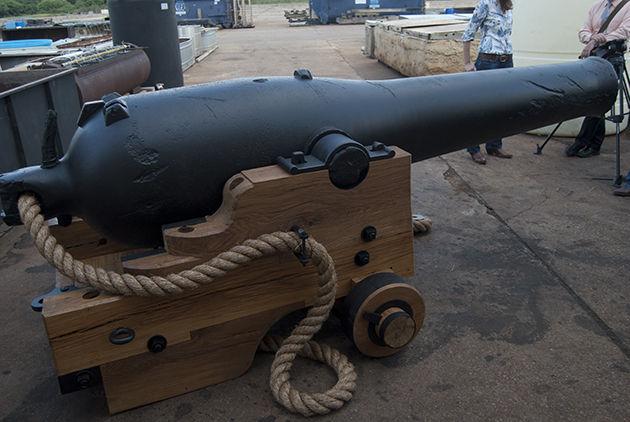In the early morning hours of New Year’s Eve 1863, Confederate forces began attacking the USS Westfield in Galveston, Texas. The Westfield went up in flames and slipped beneath the waves. The Confederates had a general idea of what was on board the vessel, but they didn’t know about the Dahlgren gun, a cannon that 151 years later has been under restoration at Texas A&M’s Riverside Campus for the past five years, said Justin Parkoff, project manager and graduate student.
Tuesday, the USS Westfield cannon was transported from Riverside Campus and will now be on display at the Texas City Museum, in Texas City.
Texas A&M has one of the longest running conservation labs in the country that specializes in artifacts that have been submerged for long periods of time, Parkoff said.
“We were the first choice because not only were we the closest to the site but we have done many cannons and not just cast iron, we have done a bronze cannon, cannons from the La Belle wreck and a revolutionary war cannon,” Parkoff said.
“This Dahlgren was brought on board secretly one night to replace one of the cannon’s that had exploded during a previous battle,” Parkoff said.
When the Confederates salvaged USS Westfield they basically knew what they were looking for, Parkoff said. They recovered all of the cannons, but they didn’t find this one because they didn’t know of its existence. 150 years later, when PBS&J, the contract company that was hired by the U.S. Army Corps of Engineers to conduct surveys of the channel and began the dredging, they found the very thing they were hoping they wouldn’t find — the USS Westfield, Parkoff said, thus beginning the rescue excavation.
Restoring a cannon is a very time consuming process, Parkoff said. The metals have to be put through electrolysis in order to remove the salts.
Since the cannon was made out of cast iron, it corroded easily, said Donny Hamilton, director of conservation research laboratory at the riverside campus. When iron is in saltwater, it builds up chloride, Hamilton said, and in order for iron not to rust, chloride has to not be present.
The cannon wasn’t the only artifact found. The Westfield project has over 8,000 artifacts in its collection, said Jessica Stika, assistant project manager of the cannon restoration. Stika’s role was to conserve the small artifacts, like the canister shot, the nine-inch shell and the sight for the cannon.
“People don’t realize when you have these sorts of excavations — actually the longest and sometimes the most expensive part of the excavation is the conservation itself and can take years,” Stika said.
The final piece for the cannon display was the gun carriage, which was built by Jim Jobling, conservation research lab manager and project manager for day-to-day operations and Glenn Grieco, model builder for the department.
“One thing about this project was we had to go back and relearn to do the same type of wood work that they did to the original,” Grieco said.
Jobling and Grieco found the authentic gun carriage through the Department of the Navy and Grieco began work on a 1:12 scale model of the carriage that was given to the museum so they could begin fundraising for the full size model.
The gun carriage is projected to be finished once it gets to the museum, Jobling said.
“We look at it with a critical eye and we see the little things we want to do to finish it,” Jobling said.
Reconstruction of the ship’s single engine cylinder will begin in late summer. A project to rebuild one of the two boilers from the Westfield will follow.
Restored cannon unveiled
June 18, 2014
Donate to The Battalion
Your donation will support the student journalists of Texas A&M University - College Station. Your contribution will allow us to purchase equipment and cover our annual website hosting costs.




















